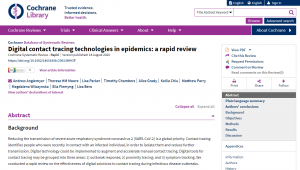Are digital contact tracing technologies effective during infectious disease outbreaks?
18 August 2020
A new Cochrane rapid review looking at the evidence for digital contact tracing has been published, with support from NIHR ARC West.
The global COVID-19 pandemic highlights the importance of accurate and timely contact tracing. Contact tracing tells people that they may have been near someone with – or showing symptoms of – an infectious disease, allowing them to self-isolate and helping to stop the spread of infection.
Digital contact tracing uses technology to track and trace contacts. Individuals download an app onto their smartphones and record location and symptom information, or their devices might use location-finding technology. If the user is infected, the technology identifies close contacts and informs people whom they have been near.
However, problems may occur where access to technology is limited, in low-income settings or for elderly people, for example. Also, some people see it as an invasion of privacy and are suspicious of how their data will be used.
The research team wanted to know whether digital contact tracing, compared to manual contact tracing, is effective in reducing the spread of infection, as measured by secondary infections, identifying close contacts, tracing a complete set of contacts, and identifying the context of infection.
They found 12 relevant studies. Six assessed the effectiveness of digital contact tracing on specific groups (cohorts) of people: three during an outbreak (Ebola in Sierra Leone; tuberculosis in Botswana; and whooping cough (pertussis) in USA); and three replicated an outbreak in schools to assess systems for identifying close contacts of participants. The remaining six were modelling studies, which simulated digital contact tracing.
Main results
Digital contact tracing with self-isolation probably reduces the number of secondary infections, but not as much as manual contact tracing with self-isolation (two modelling studies).
Digital contact tracing found more close contacts in two outbreaks than manual (two studies in USA and Sierra Leone). Devices in non-outbreak settings can identify more close contacts than self-reported diaries or surveys.
An app may reduce the time to complete a set of close contacts (one study). Digital systems were faster to use than paper systems for recording new contacts and monitoring known contacts, and possibly less prone to data loss.
Problems with system access (two studies) included patchy network coverage, lack of data, technical problems and higher staff training needs. Contact tracers’ personal expenses increased (one study) due to travel and recharging phone batteries. Devices all appeared to protect diagnosed users from contacts, snoopers and authorities but one app’s users were members of public health agencies. Studies recorded stolen hardware (second-hand mobile phones); reported that paper forms were “often lost”, and that digital data were password protected (two studies) and encrypted (one study).
They found no evidence on contextual information and acceptability.
What this means
It is unlikely that digital technologies would be the sole method of contact tracing during an outbreak; they would probably be used alongside manual methods. Unfortunately, the technology is largely unproven in real-world outbreak settings and none of our included studies assessed digital plus manual contact tracing with digital contact tracing alone. The included studies assessed different technologies and used different methods from each other, so the team are uncertain about their evidence.
Governments that implement digital contact tracing should ensure that at-risk populations are not disadvantaged and take privacy concerns into account.
This review is up to date to May 2020.
Paper
Digital contact tracing technologies in epidemics: a rapid review
Andrew Anglemyer, Theresa HM Moore, Lisa Parker, Timothy Chambers, Alice Grady, Kellia Chiu, Tom Cunningham, Matthew Parry, Magdalena Wilczynska, Ella Flemyng, Lisa Bero
Paper
